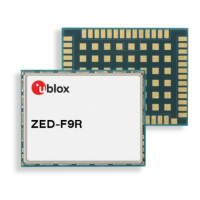ZED-F9R-Integration manual
The startup procedure is as follows:
• The host powers on the u-blox receiver.
• The u-blox receiver detects the previously stored data in the flash. It restores the corresponding
memory and reports the success of the operation with a UBX-UPD-SOS-RESTORED message
on the port on which it had received the save command message (if the output protocol filter on
that port allows it). It does not report anything if no stored data has been detected.
• Additionally the u-blox receiver outputs a UBX-INF-NOTICE and/or a NMEA-TXT message
with the contents RESTORED in the boot screen (depends on the configuration of the port and
information messages) upon success.
• Optionally the host can deliver coarse time assistance using UBX-MGA-INI-TIME_UTC for
better startup performance.
Once the u-blox receiver has started up it is recommended to delete the stored data using a UBX-
UPD-SOS-CLEAR message. The u-blox receiver responds with a UBX-ACK-ACK / UBX-ACK-NAK
message.
CAUTION Note that the save-on-shutdown feature works correctly only when the receiver
has a valid time information when saving the SOS-BACKUP.
3.9.4 Advanced calibration handling
Supported from firmware version HPS 1.30 onwards
The advanced calibration handling feature enables a host to poll and later send sensor initialization
and calibration parameters. This information can be used to aid quick recovery of the receiver into
sensor fusion or dead reckoning mode following a device reset or power down, especially when the
battery backup is not provided or the save-on-shutdown feature is not used.
The following points outline the procedure when using the advanced calibration handling feature:
•
Host should poll UBX-MGA-SF regularly (optimal time: every 5 min.) after the fusion mode has
been achieved. The UBX-ESF-STATUS.fusionMode field should be set to 1:FUSION before
polling the UBX-MGA-SF message.
•
Receiver replies with one or more UBX-MGA-SF messages. These messages should be stored at
the host side.
•
In the event of a reset or a power down, host can send the latest stored UBX-MGA-SF messages
to the receiver. If there is a sudden power off, the user has to provide the last known position
and the attitude solution to the receiver after the power cycle.
• The receiver attempts to reach sensor fusion mode using the data available in these messages.
• Depending on the availability of the GNSS signals the receiver can switch to either fusion mode
(3D + DR) or dead reckoning mode (DR only). Host can poll UBX-ESF-STATUS to track the status
of the sensors' calibration.
UBX-MGA-SF message is not output periodically, therefore it is required that the host polls
the message regularly. This ensures that the host saves the latest parameters required for
quick recovery into sensor fusion mode.
Make sure to send the latest UBX-MGA-SF messages to the receiver. Sending outdated
messages could mean the receiver will take longer to reach sensor fusion mode.
Only send the saved UBX-MGA-SF messages to the same receiver they were obtained from.
After the power cycle, the user needs to provide the last known position and the attitude via
UBX-MGA-INI-POS and UBX-MGA-INI-ATT messages. The information can be taken from
UBX-NAV-PVT and UBX-NAV-ATT or UBX-NAV-PVAT.
UBX-20039643 - R06
3 Receiver functionality Page 64 of 119
C1-Public

